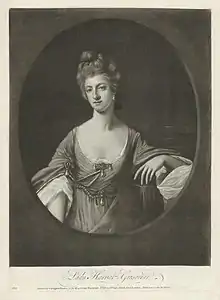Henrietta, Lady Grosvenor
Henrietta, Lady Grosvenor (c. 1745 - 1828) was an English aristocrat, socialite, and courtesan.
Henrietta, Lady Grosvenor | |
|---|---|
 | |
| Born | Henrietta Vernon c. 1745 |
| Died | 1828 (aged 82–83) |
| Spouse(s) | George Porter (m. 1802) |
| Parent(s) | James Vernon Lady Henrietta Wentworth |
Born Henrietta Vernon, she was one of four daughters born to Lady Henrietta Wentworth and her husband James Vernon of Hilton Hall, former Member of Parliament for Lichfield and Newcastle under Lyme.[1]
On 19 July 1764 she married Baron Richard Grosvenor, later 1st Earl Grosvenor (1731–1802) at St George's Church, Hanover Square.[2] They had four sons.[1]
In 1769 she was discovered in flagrante delicto with the Duke of Cumberland, brother of King George III. Their affair became a national scandal when her husband sued the Duke on the grounds of 'criminal conversation' with his wife, and the lovers' correspondence was published in the press as part of the trial reports. The jury awarded the baronet damages of £10,000 pounds in recognition of the damage to his marital property.[3]
Lady Grosvenor prevented the Baron from securing a divorce on the grounds of her adultery by gathering evidence of his own extensive sexual misconduct, personally 'going into bawdy houses [...] to search and procure witnesses'.[3] The diarist and artist Joseph Farington dubbed Lord Grosvenor as 'one of the most profligate men of his age, in what relates to women'.[2] This wealth of evidence meant that the Baron could not be granted an annulment, and was obliged to support his wife for the rest of his life. The couple's legal separation in 1771 included yearly maintenance payments of £1200 to Lady Grosvenor.[3]
She lived in Paris and London in the subsequent years, with the emotional and financial support of several men, and the press continued to report on her lovers and her appearances at social occasions for decades. She was a member of the social club for the 'demi-reps' nicknamed the New Female Coterie by the English press, whose members comprised fellow elite women publicly shamed for infidelity such as Caroline Stanhope, Countess of Harrington and Seymour Dorothy Fleming. Janine Barchas suggests that the legacy of the scandals attached to Henrietta Vernon may have inspired Jane Austen in writing her early epistolary novel Lady Susan, which centres on the charming and flirtatious Lady Susan Vernon.[4]
On 1 September 1802 Lady Grosvenor married her longtime companion, the Whig MP George Porter, the son of the British diplomat James Porter. George later inherited the Hungarian title of Baron de Hochepied through his mother's line, making Henrietta the Baroness de Hochepied. She died in 1828 in Ealing.[1]
References
- "Grosvenor, Richard, first Earl Grosvenor (1731–1802), politician and landowner". Oxford Dictionary of National Biography. doi:10.1093/ref:odnb/11669. Retrieved 2021-01-15.
- Curzon, Catherine. The scandal of George III's court. Barnsley, South Yorkshire. p. 40. ISBN 978-1-4738-7254-7. OCLC 1100940380.
- Rubenhold, Hallie (2008). Lady Worsley's whim : an eighteenth-century tale of sex, scandal and divorce. London: Chatto & Windus. pp. 176–180. ISBN 978-0-7011-7980-9. OCLC 241029175.
- Barchas, Janine (2012). Matters of fact in Jane Austen : history, location, and celebrity. Baltimore: The Johns Hopkins University Press. pp. 49–52. ISBN 1-4214-0731-0. OCLC 857084436.